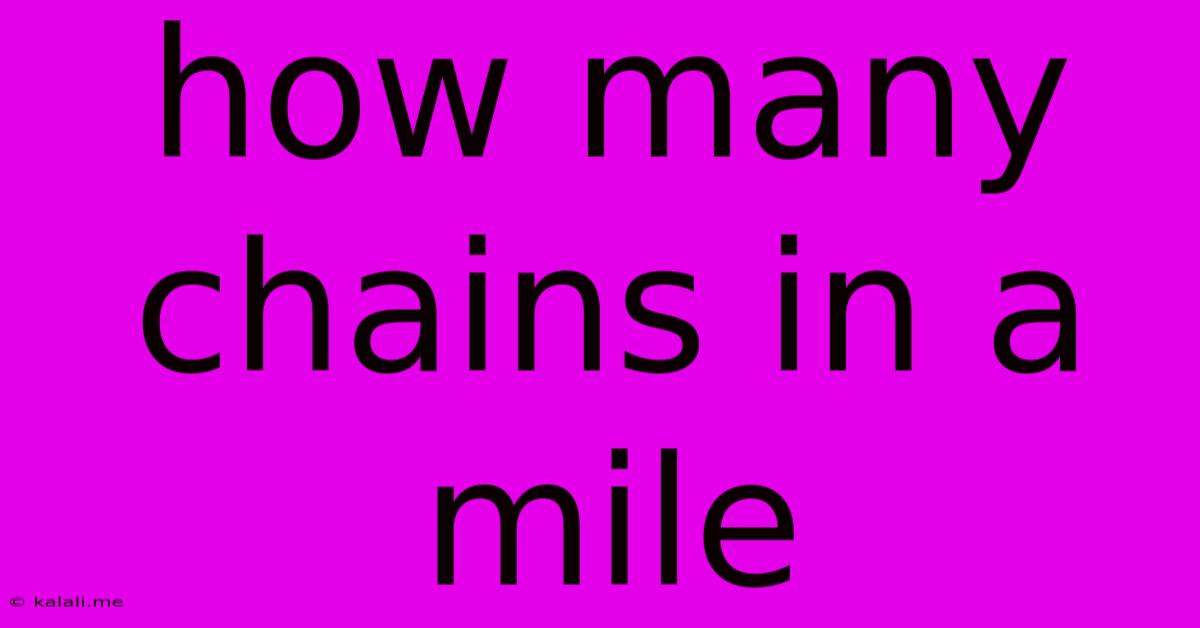How Many Chains In A Mile
Kalali
Jun 11, 2025 · 2 min read

Table of Contents
How Many Chains in a Mile? A Deep Dive into Surveying and Measurement
Ever wondered how many chains are in a mile? This seemingly simple question delves into the fascinating world of historical land surveying and the units of measurement we still use today. Understanding this conversion is not only helpful for historical context but also for anyone working with land measurement, particularly in older documents or maps. This article will clarify the conversion and explore its relevance today.
Understanding the Chain as a Unit of Measurement
The chain, also known as Gunter's chain, is a unit of length historically used in surveying. It's equal to 66 feet, or 22 yards, and is subdivided into 100 links, each 7.92 inches long. This specific length wasn't chosen arbitrarily; it was designed to simplify land surveying calculations, particularly when dealing with acres.
The Conversion: Chains to Miles
Now, for the answer you're looking for: There are 80 chains in one mile. This is because a mile contains 5280 feet, and since a chain is 66 feet, 5280 feet divided by 66 feet per chain equals 80 chains. This conversion remains consistent regardless of the geographical location.
Why is this Conversion Still Relevant?
While the metric system is predominantly used in many parts of the world, the chain remains relevant for a few key reasons:
- Historical Documents: Many land records and older maps utilize the chain as the unit of measurement. Understanding this conversion is crucial for interpreting these documents accurately. Property lines, easements, and other vital information are often described using chains and links.
- Specific Industries: Certain industries, particularly those dealing with surveying and land management, might still employ the chain for legacy reasons or specific project requirements.
- Understanding Legacy Systems: Knowing about the chain provides context to the evolution of measurement systems and how they relate to modern units. This understanding enhances comprehension of historical practices and data interpretation.
Beyond the Simple Conversion: Working with Chains and Links
It's important to note that while the conversion from chains to miles is straightforward, working with chains often involves understanding the smaller unit – the link. This granular level of detail is essential for precise land surveying and mapping. Calculations often involve both chains and links, necessitating a thorough understanding of their relationship.
Conclusion:
The seemingly simple question of "how many chains in a mile?" opens a window into a rich history of measurement and land surveying. While the metric system is increasingly prevalent, the chain remains a relevant unit for interpreting historical documents, engaging with specific industries, and understanding the evolution of measurement systems. Remembering that there are 80 chains in a mile provides a crucial link (pun intended!) to this historical legacy and its continued relevance today.
Latest Posts
Latest Posts
-
How Many Feet In A Quarter Acre
Jul 01, 2025
-
How Many Feet Is Half An Acre
Jul 01, 2025
-
If I Was Born In 2004 How Old Am I
Jul 01, 2025
-
How Long Would It Take To Drive 2000 Miles
Jul 01, 2025
-
What Color Does Black And Blue Make
Jul 01, 2025
Related Post
Thank you for visiting our website which covers about How Many Chains In A Mile . We hope the information provided has been useful to you. Feel free to contact us if you have any questions or need further assistance. See you next time and don't miss to bookmark.